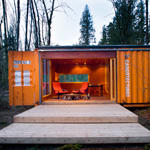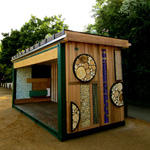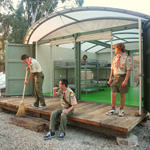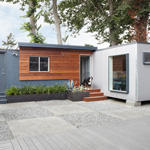Architectural innovation
Boucher Grygier Residence, Berkeley, CA
Seatrain House
Los Angeles, CA
When life gives you lemons, make lemonade, right? That’s what designer Jennifer Siegal did when a client asked her to build on the site of a former junkyard in downtown Los Angeles. Where most would have carted everything away, Siegal salvaged containers and other materials from the site, then integrated them seamlessly into this bold, modern home.
c320 Studio
Aberdeen, WA
HyBrid Architecture has a crush on the container, using it for everything from backyard studios to Cargotown, a design scheme they’ve proposed for Seattle’s new waterfront. The c320 Studio was commissioned in 2005 by the owner of an organic farm in the Pacific Northwest. HyBrid designed this 320-square-foot retreat for the property’s most scenic corner, providing a sort of escape without leaving town. The architects thought the installation would take about ten hours, says HyBrid principal Robert Humble, but “it actually took about three hours, and then everyone had lunch and enjoyed the new home around us!”
Green Roof Shelters
A collaboration between San Francisco’s Lisa Lee Benjamin and “a team of inventive, kooky Brits,” Green Roof Shelters explores what is possible to create from our existing resources. This prototype is one of a planned series of designed habitats made expressly for insects and birds.
Siegal Residence, Venice, CA
Boy Scout Cabin
Catalina Island, CA
As reliable as a troop of Boy Scouts, shipping containers were the perfect building block for the eco-cabins Gensler designed for them. As architect Richard Hammond explains, “What we liked about containers we kept, what we didn’t like we changed.” Cheap, readily available and incredibly sustainable, Gensler’s cabins lay lightly on the land and are a fun and comfy teaching tool for the scouts they stylishly shelter.
Tim Palen Studio at Shadow Mountain, Joshua Tree, CA
building Lab Office
Oakland, CA
Stephen Shoup’s sleek backyard office is all about reuse. In addition to the metal shipping container that once sat at the Port of Oakland, the resourceful architect also used a discarded freezer, a door acquired from a salvage yard, and made a window from a former sliding door. The interior embraces sustainability as well with such green features interior walls clad with reclaimed fir and a rooftop solar hot-water system to heat the space.










